TOYOTA PRIUS PLUG-IN HYBRID 2014 1.G Quick Reference Guide
Manufacturer: TOYOTA, Model Year: 2014, Model line: PRIUS PLUG-IN HYBRID, Model: TOYOTA PRIUS PLUG-IN HYBRID 2014 1.GPages: 40, PDF Size: 4.58 MB
Page 11 of 40

9
Hood release
Pull up latch and
raise hood
Light control-Instrument panel
Brightness
control
-
+
Engage support rod
Pull
OVERVIEWELECTRIC VEHICLE SYSTEM FEATURES/OPERATIONS
SAFETY AND EMERGENCY FEATURES
Page 12 of 40
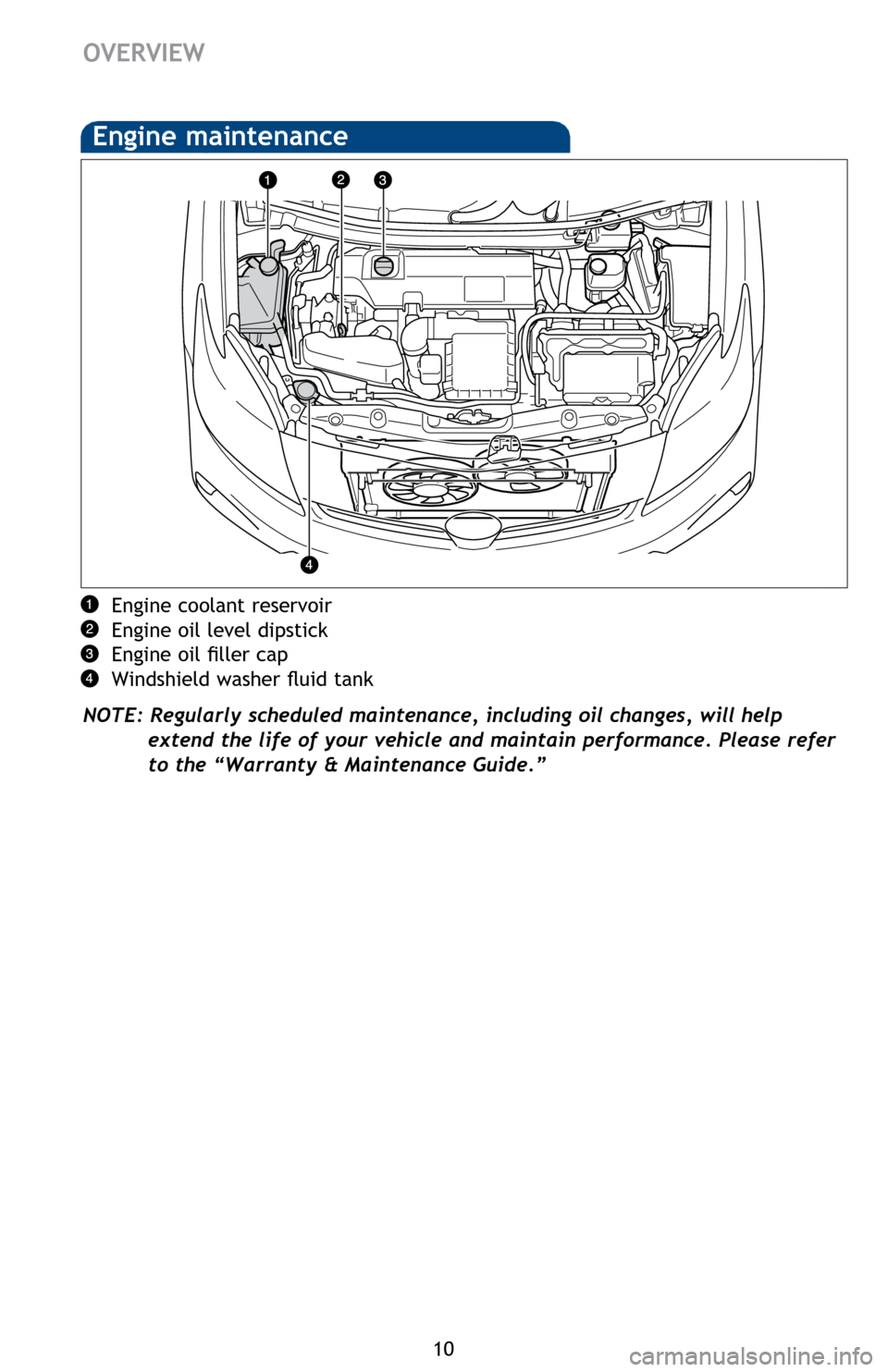
10
Engine coolant reservoir
Engine oil level dipstick
Engine oil filler cap
Windshield washer fluid tank
NOTE: Regularly scheduled maintenance, including oil changes, will help extend the life of your vehicle and maintain performance. Please refer
to the “Warranty & Maintenance Guide.”
Engine maintenance
OVERVIEW
Page 13 of 40
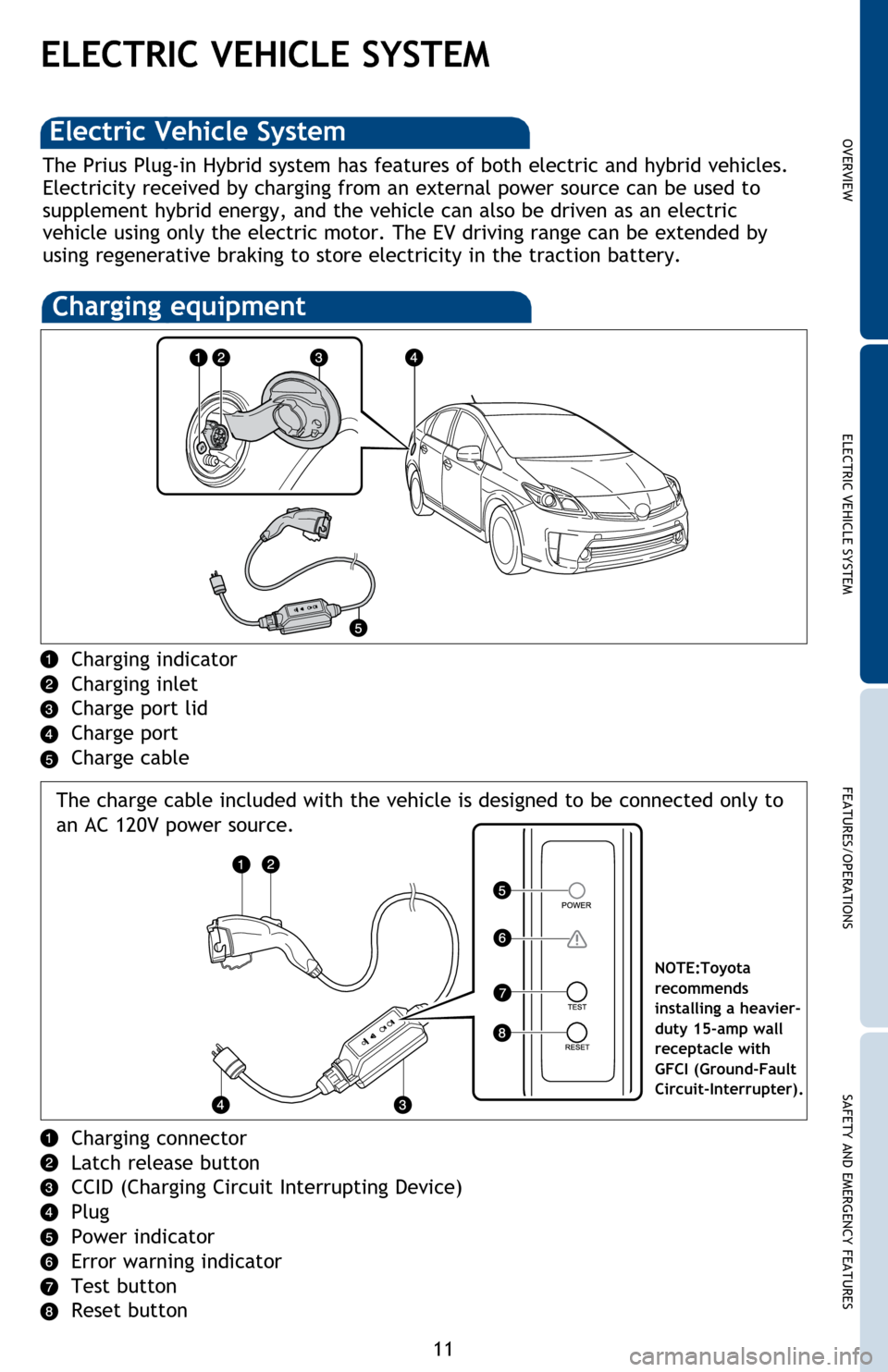
11
ELECTRIC VEHICLE SYSTEM
The Prius Plug-in Hybrid system has features of both electric and hybrid vehicles.
Electricity received by charging from an external power source can be used to
supplement hybrid energy, and the vehicle can also be driven as an electric
vehicle using only the electric motor. The EV driving range can be extended by
using regenerative braking to store electricity in the traction battery.
Electric Vehicle System
Charging indicator
Charging inlet
Charge port lid
Charge port
Charge cable
Charging equipment
Charging connector
Latch release button
CCID (Charging Circuit Interrupting Device)
Plug
Power indicator
Error warning indicator
Test button
Reset button
The charge cable included with the vehicle is designed to be connected only to
an AC 120V power source.
NOTE:Toyota
recommends
installing a heavier-
duty 15-amp wall
receptacle with
GFCI (Ground-Fault
Circuit-Interrupter).
OVERVIEWELECTRIC VEHICLE SYSTEM FEATURES/OPERATIONS
SAFETY AND EMERGENCY FEATURES
Page 14 of 40
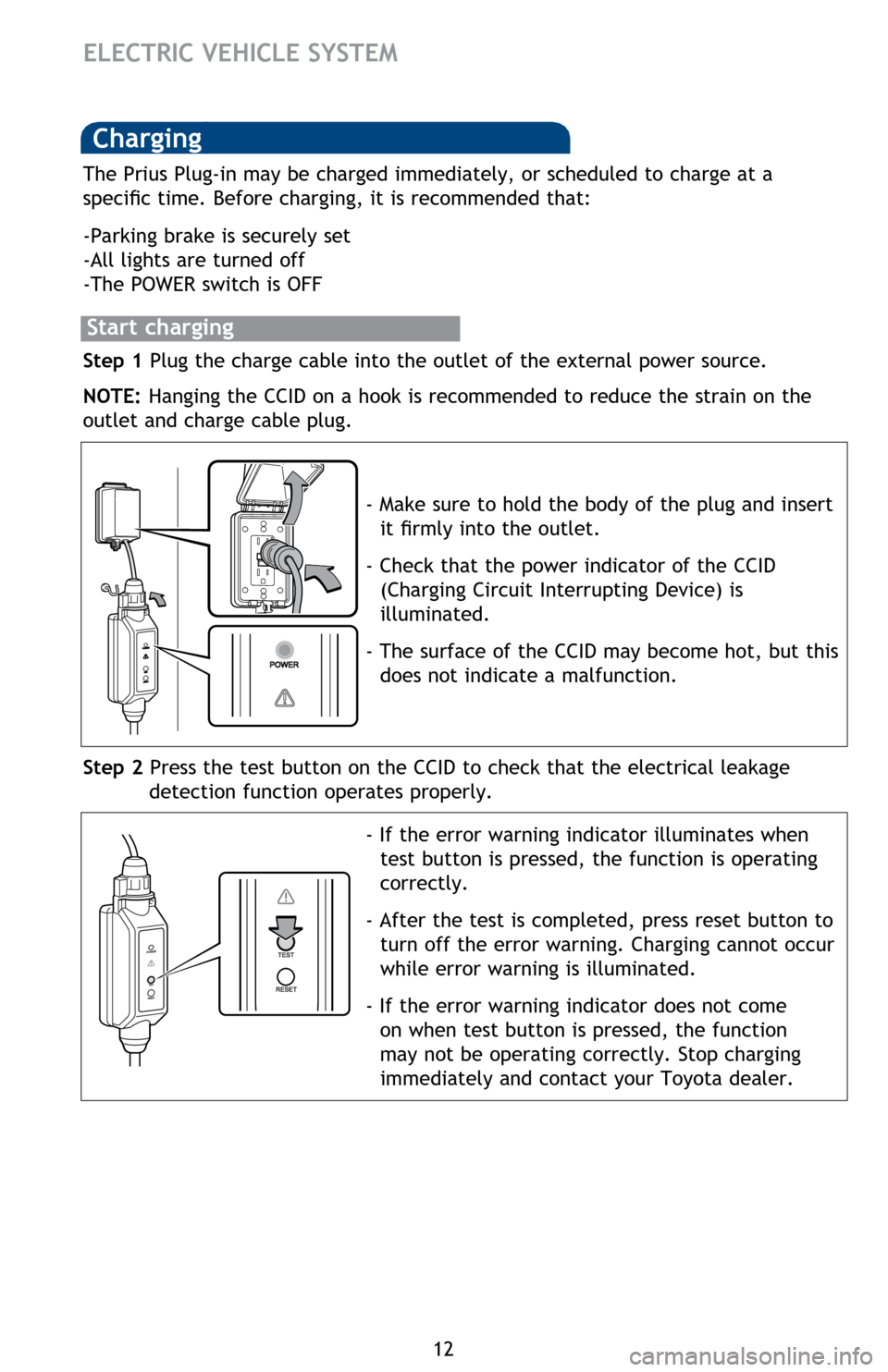
12
ELECTRIC VEHICLE SYSTEM
Charging
Step 1 Plug the charge cable into the outlet of the external power source.
NOTE: Hanging the CCID on a hook is recommended to reduce the strain on the
outlet and charge cable plug.
- Make sure to hold the body of the plug and insert it firmly into the outlet.
- Check that the power indicator of the CCID (Charging Circuit Interrupting Device) is
illuminated.
- The surface of the CCID may become hot, but this does not indicate a malfunction.
Step 2 Press the test button on the CCID to check that the electrical leakage detection function operates properly.
- If the error warning indicator illuminates when test button is pressed, the function is operating
correctly.
- After the test is completed, press reset button to turn off the error warning. Charging cannot occur
while error warning is illuminated.
- If the error warning indicator does not come on when test button is pressed, the function
may not be operating correctly. Stop charging
immediately and contact your Toyota dealer.
The Prius Plug-in may be charged immediately, or scheduled to charge at a
specific time. Before charging, it is recommended that:
-Parking brake is securely set
-All lights are turned off
-The POWER switch is OFF
Start charging
Page 15 of 40
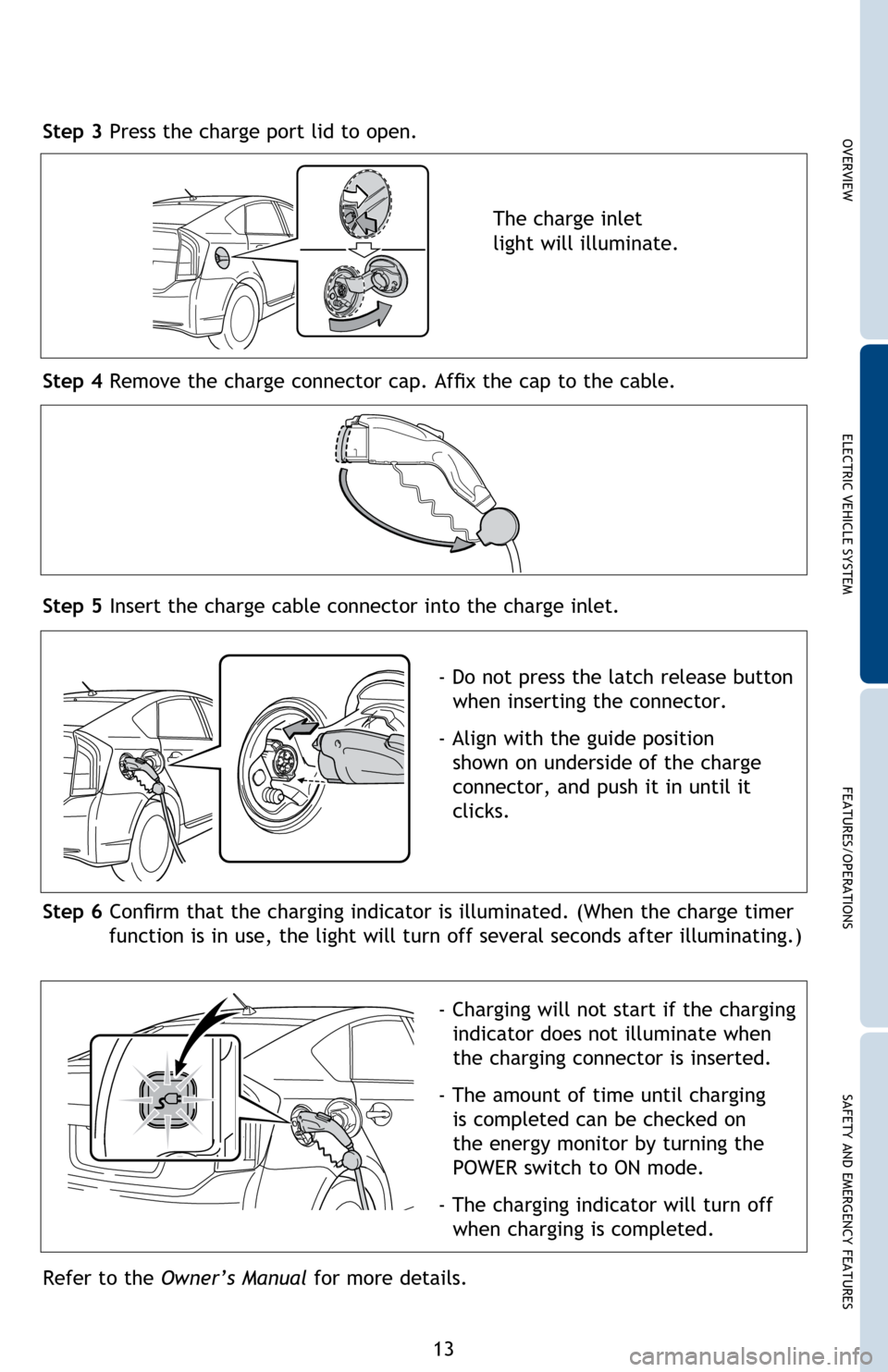
13
Step 3 Press the charge port lid to open.
Step 4 Remove the charge connector cap. Affix the cap to the cable.
The charge inlet
light will illuminate.
Step 5 Insert the charge cable connector into the charge inlet.
- Do not press the latch release button when inserting the connector.
- Align with the guide position shown on underside of the charge
connector, and push it in until it
clicks.
Step 6 Confirm that the charging indicator is illuminated. (When the charge timer function is in use, the light will turn off several seconds after illuminating.)
- Charging will not start if the charging indicator does not illuminate when
the charging connector is inserted.
- The amount of time until charging is completed can be checked on
the energy monitor by turning the
POWER switch to ON mode.
- The charging indicator will turn off when charging is completed.
Refer to the Owner’s Manual for more details.
OVERVIEWELECTRIC VEHICLE SYSTEM FEATURES/OPERATIONS
SAFETY AND EMERGENCY FEATURES
Page 16 of 40
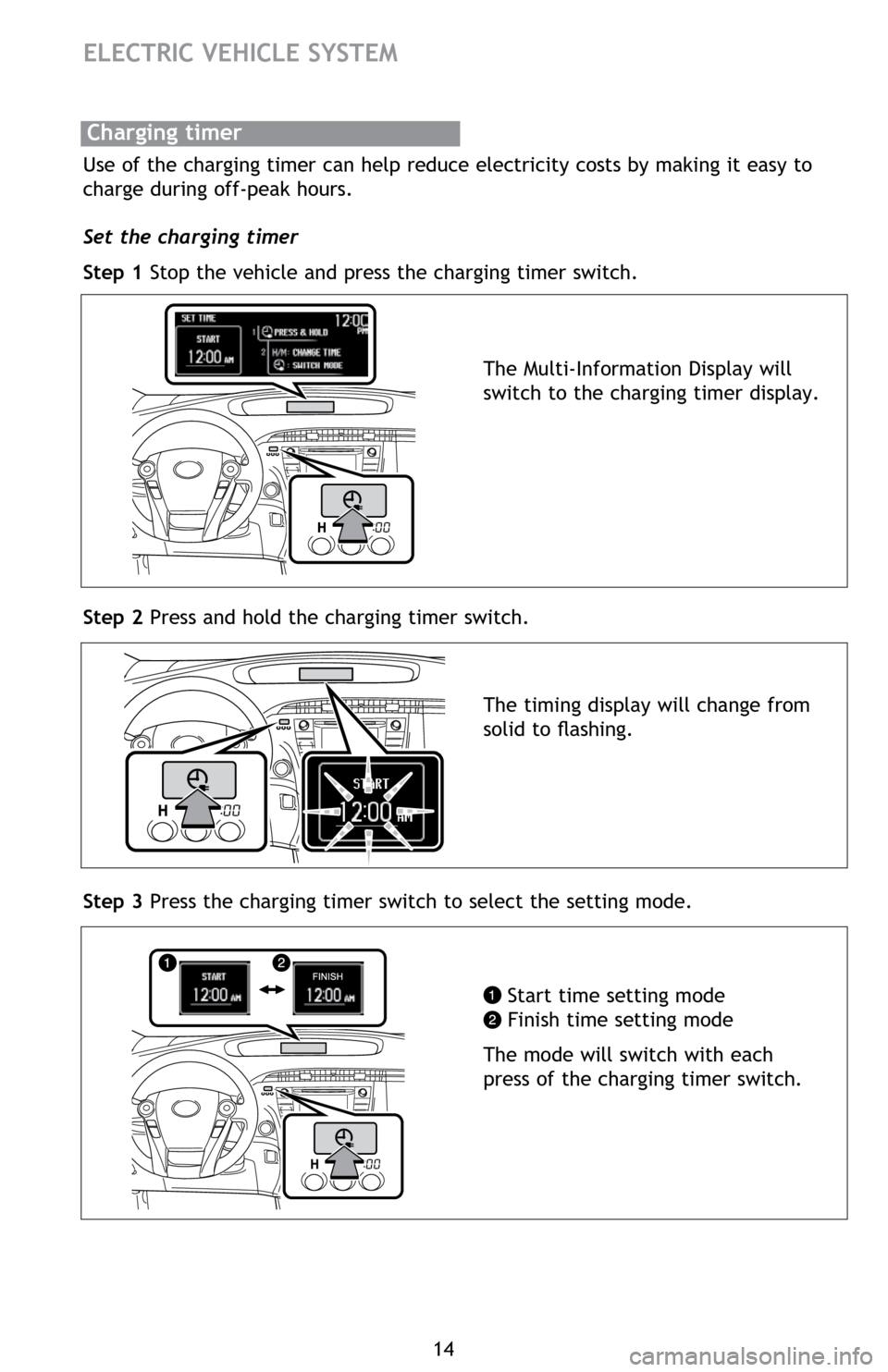
14
ELECTRIC VEHICLE SYSTEM
Use of the charging timer can help reduce electricity costs by making it easy to
charge during off-peak hours.
Set the charging timer
Step 1 Stop the vehicle and press the charging timer switch.
The timing display will change from
solid to flashing.
Charging timer
The Multi-Information Display will
switch to the charging timer display.
Step 2 Press and hold the charging timer switch.
Step 3 Press the charging timer switch to select the setting mode. Start time setting mode
Finish time setting mode
The mode will switch with each
press of the charging timer switch.
Page 17 of 40
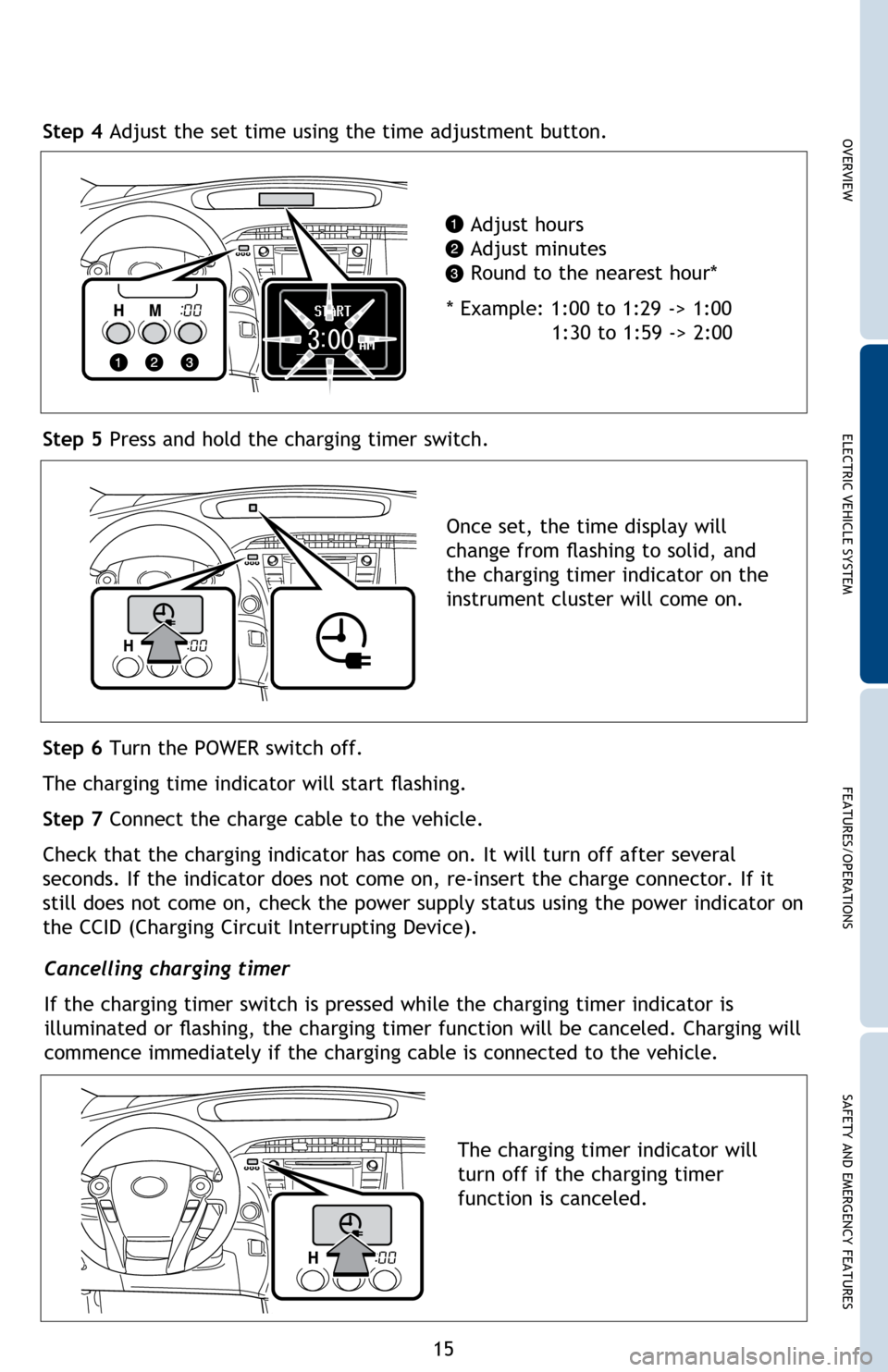
15
Cancelling charging timer
If the charging timer switch is pressed while the charging timer indicator is
illuminated or flashing, the charging timer function will be canceled. Charging will
commence immediately if the charging cable is connected to the vehicle.
Step 5 Press and hold the charging timer switch.
Step 6 Turn the POWER switch off.
The charging time indicator will start flashing.
Step 7 Connect the charge cable to the vehicle.
Check that the charging indicator has come on. It will turn off after several
seconds. If the indicator does not come on, re-insert the charge connector. If it
still does not come on, check the power supply status using the power indicator on
the CCID (Charging Circuit Interrupting Device).
Step 4 Adjust the set time using the time adjustment button.
Adjust hours
Adjust minutes
Round to the nearest hour*
* Example: 1:00 to 1:29 -> 1:00
1:30 to 1:59 -> 2:00
Once set, the time display will
change from flashing to solid, and
the charging timer indicator on the
instrument cluster will come on.
The charging timer indicator will
turn off if the charging timer
function is canceled.
OVERVIEWELECTRIC VEHICLE SYSTEM FEATURES/OPERATIONS
SAFETY AND EMERGENCY FEATURES
Page 18 of 40
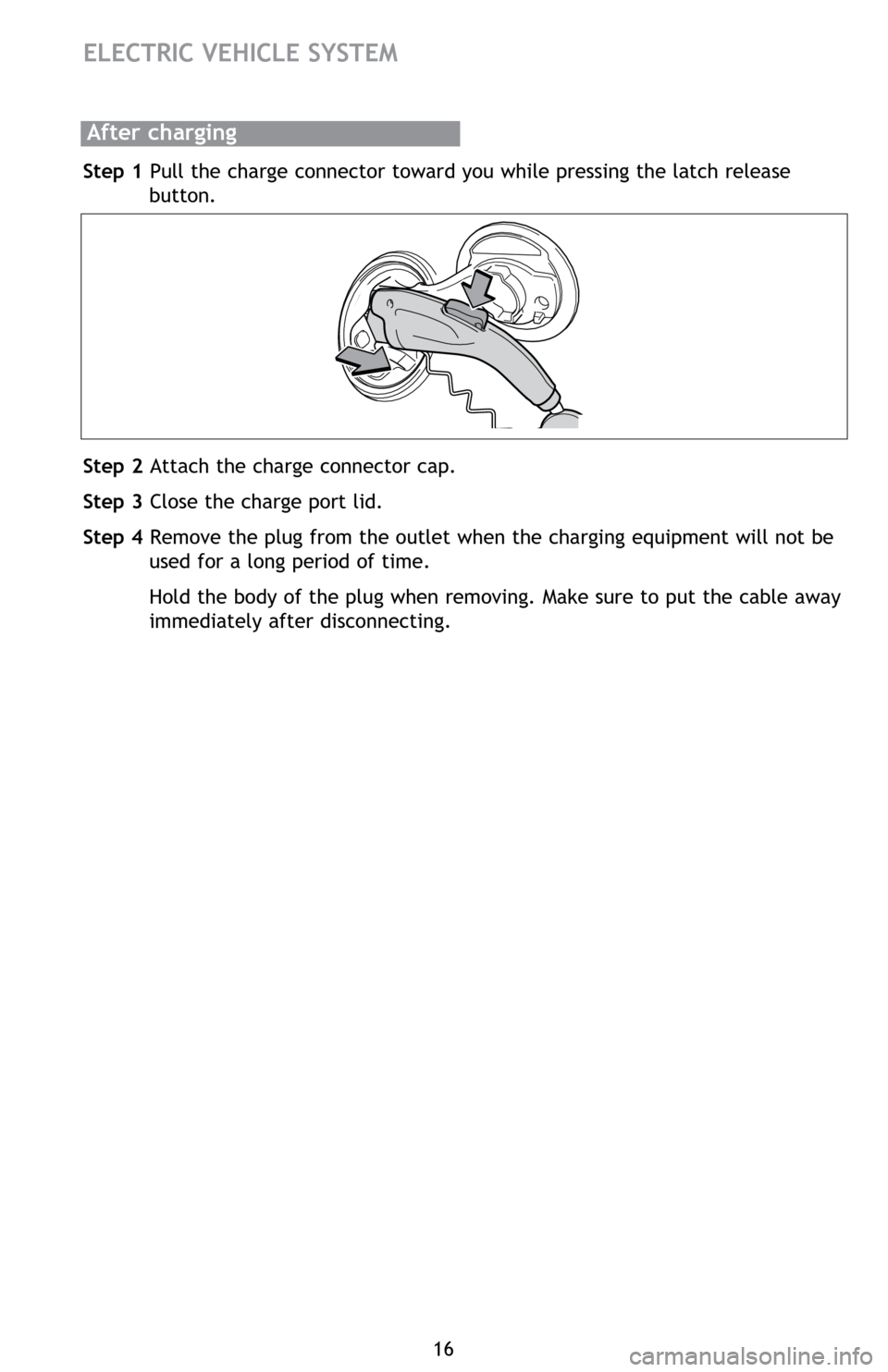
16
ELECTRIC VEHICLE SYSTEM
Step 1 Pull the charge connector toward you while pressing the latch release button.
Step 2 Attach the charge connector cap.
Step 3 Close the charge port lid.
Step 4 Remove the plug from the outlet when the charging equipment will not be used for a long period of time.
Hold the body of the plug when removing. Make sure to put the cable away
immediately after disconnecting.
After charging
Page 19 of 40

17
Charging information and warning messages The first time the POWER switch is
turned to ON mode after charging is completed, a message detailing the results
of the charge is shown. Also, if an operation that cannot be carried out during
charging was attempted, a warning message will be shown. Remaining charging time Charging information is displayed on the
Multi-Information Display.
If the POWER switch is turned to ON mode during charging, the current charging
status and the amount of time needed until charging is complete will be displayed
on the energy monitor.
After confirming, switch the POWER switch to OFF and turn off the display. The
POWER switch will turn off automatically after several tens of seconds.
Multi-Information Display-Charging
information
Follow the instructions in the message. The message may not be displayed if the
Remote Climate System has been used.
See the Owner’s Manual for more details.
OVERVIEWELECTRIC VEHICLE SYSTEM FEATURES/OPERATIONS
SAFETY AND EMERGENCY FEATURES
Page 20 of 40
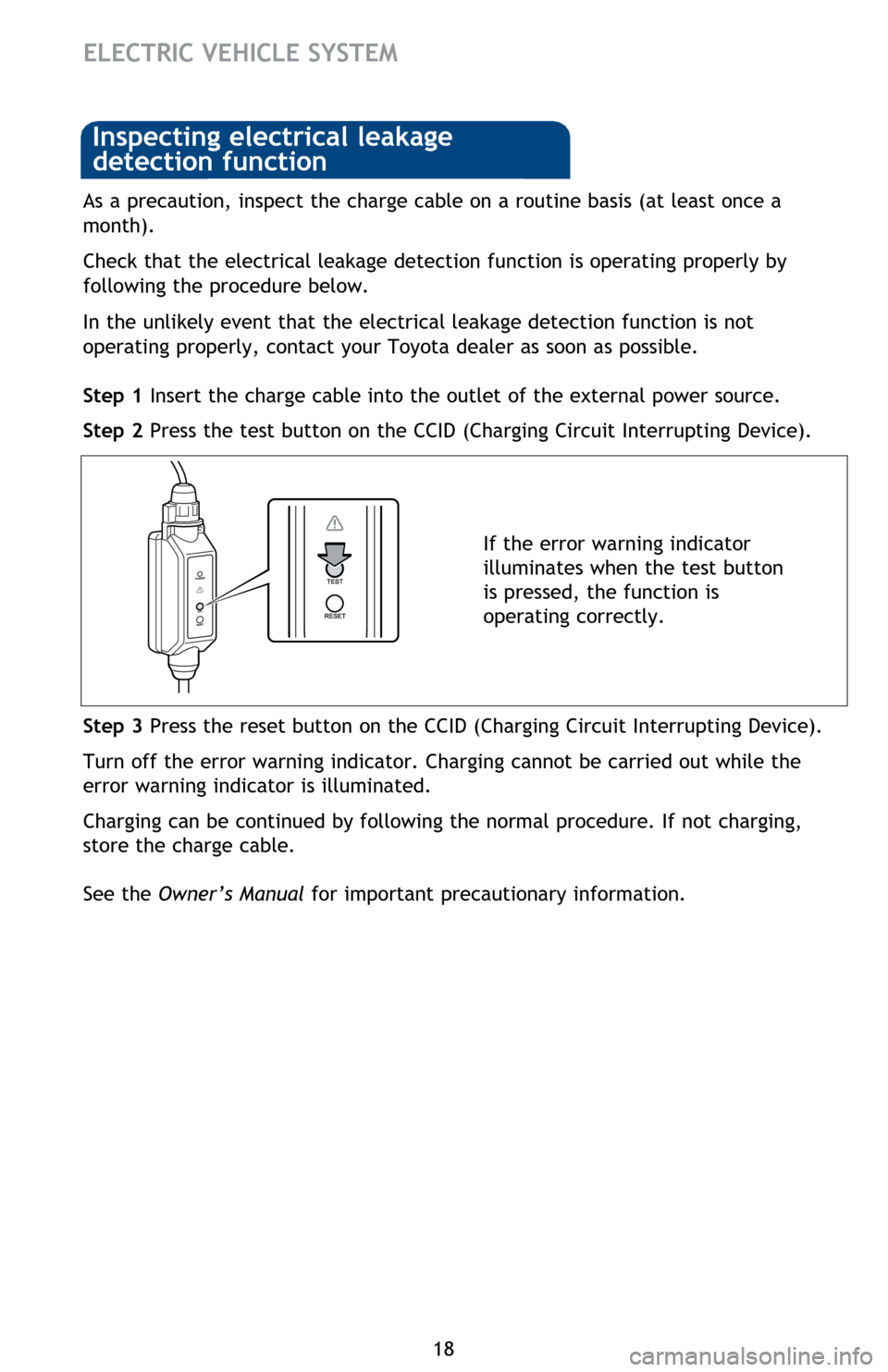
18
As a precaution, inspect the charge cable on a routine basis (at least once a
month).
Check that the electrical leakage detection function is operating properly by
following the procedure below.
In the unlikely event that the electrical leakage detection function is not
operating properly, contact your Toyota dealer as soon as possible.
Step 1 Insert the charge cable into the outlet of the external power source.
Step 2 Press the test button on the CCID (Charging Circuit Interrupting Device).
If the error warning indicator
illuminates when the test button
is pressed, the function is
operating correctly.
Step 3 Press the reset button on the CCID (Charging Circuit Interrupting Device).
Turn off the error warning indicator. Charging cannot be carried out while the
error warning indicator is illuminated.
Charging can be continued by following the normal procedure. If not charging,
store the charge cable.
See the Owner’s Manual for important precautionary information.
Inspecting electrical leakage
detection function
ELECTRIC VEHICLE SYSTEM